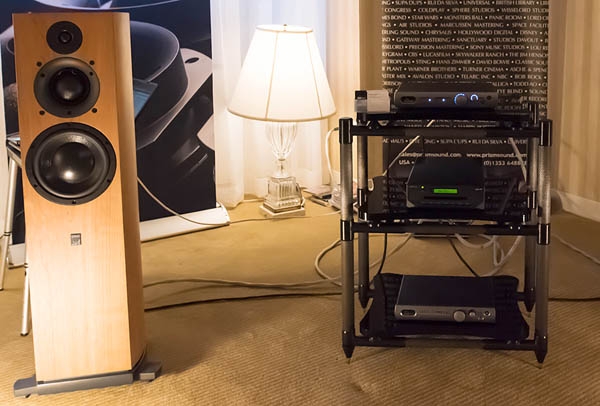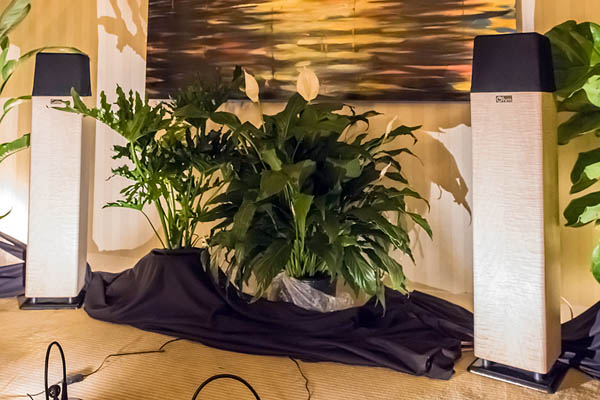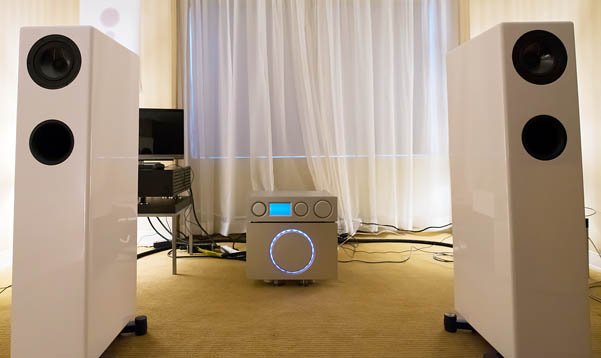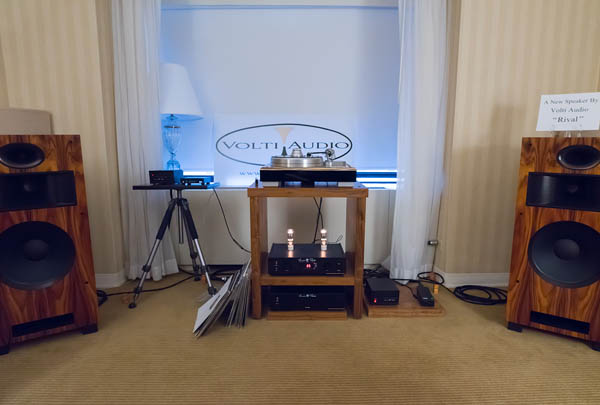
30
Dec, 2016
STEREOPHILE ON NYAS 2016: DAY ONE WITH JIM AUSTIN
 I don’t get out much. In particular, I don’t normally go to audio shows. But this weekend I attended the New York Audio Show, which was held at the Park Lane Hotel, on the south end of Manhattan’s Central Park—just a short subway ride (followed by a shorter walk) from my New York apartment. It was pleasant enough, I suppose, but also a good reminder of the reasons I don’t usually go to audio shows. Reason # 1: There are people there. People who aren’t me. With opinions. Reason # 2: A hotel is a lousy place to demonstrate a fine audio system. Some clichés are true, as was apparent in the first room I walked into, the Prism Sound room, where the company’s $2750 Callia DAC/preamp/headphone amplifier was being demoed with a pair of ATC SCM 40A active monitors, a computer running JRiver, and some cables. The room was small, approximately square, with low ceilings, and—like all the rooms I visited at the show—very yellow. Prism’s Mark Evans told me they’d set up the room three times and torn it apart twice; they ended their work with the speakers firing diagonally across the room, with big bass traps in corners and some sound-absorbing panels at reflection points. The resulting sound was good, not great: rich and full with a soundstage of some depth and adequate width, but a bit fuzzy. The room made it impossible to judge the Callia’s sound, but the company’s history makes the DAC interesting by default. Prism has long been an established leader in the pro-audio world, but the British-made Callia—the name means “beautiful voice” in Greek—is their first consumer DAC. The Callia has all the usual inputs and natively handles PCM up to 192/24; it can play files up to 384/32, but it decimates these higher resolutions down to 192/24, which should not affect sound quality. The Callia handles DSD, too, via its USB input, but it’s a PCM-centric DAC: DSD must first be converted to DoP (DSD-over-PCM) and then is converted to PCM internally. Anyone who feels, as I do, that a pro heritage is a good thing in a source component, should consider adding the Callia to their audition list.
I don’t get out much. In particular, I don’t normally go to audio shows. But this weekend I attended the New York Audio Show, which was held at the Park Lane Hotel, on the south end of Manhattan’s Central Park—just a short subway ride (followed by a shorter walk) from my New York apartment. It was pleasant enough, I suppose, but also a good reminder of the reasons I don’t usually go to audio shows. Reason # 1: There are people there. People who aren’t me. With opinions. Reason # 2: A hotel is a lousy place to demonstrate a fine audio system. Some clichés are true, as was apparent in the first room I walked into, the Prism Sound room, where the company’s $2750 Callia DAC/preamp/headphone amplifier was being demoed with a pair of ATC SCM 40A active monitors, a computer running JRiver, and some cables. The room was small, approximately square, with low ceilings, and—like all the rooms I visited at the show—very yellow. Prism’s Mark Evans told me they’d set up the room three times and torn it apart twice; they ended their work with the speakers firing diagonally across the room, with big bass traps in corners and some sound-absorbing panels at reflection points. The resulting sound was good, not great: rich and full with a soundstage of some depth and adequate width, but a bit fuzzy. The room made it impossible to judge the Callia’s sound, but the company’s history makes the DAC interesting by default. Prism has long been an established leader in the pro-audio world, but the British-made Callia—the name means “beautiful voice” in Greek—is their first consumer DAC. The Callia has all the usual inputs and natively handles PCM up to 192/24; it can play files up to 384/32, but it decimates these higher resolutions down to 192/24, which should not affect sound quality. The Callia handles DSD, too, via its USB input, but it’s a PCM-centric DAC: DSD must first be converted to DoP (DSD-over-PCM) and then is converted to PCM internally. Anyone who feels, as I do, that a pro heritage is a good thing in a source component, should consider adding the Callia to their audition list.  The problem with hotel rooms, though, isn’t limited to sound. It includes smell. The second room I entered—after Prism Sound—was the Wes Bender Studio NYC room. When I got to the room, Wes was busy dealing with hotel staff, seeking a way to deal with the room’s smells; it seems likely that the toilet had overflowed not too long ago, soaking the carpet. Wes had retrieved a bottle of carpet cleaner and was preparing to soak the carpet. The Wes Bender room had a Danish theme; it featured GamuT everything, with a tiny bit of Ortofon. The lovely stand-mounted speakers were GamuT’s RS3i ($20,990/pair); they were spaced widely along the narrow room’s long wall. Electronics were the GamuT D3i dual-mono line-level preamp ($8380), the D200i dual-mono stereo preamplifier ($13,990), and a CD3 CD player ($7990). Cabling was from GamuT’s Reference series. The Ortofon touch was a step-up transformer sitting on the big (42″) Stillpoints ESS rack ($10,700). The analog source was the lovely Slovenian-built—and Stereophile A-rated—Pear Audio Blue Kid Thomas Turntable ($7995 with their Cornet 2 tonearm), assisted by the company’s Blue Classic phono stage ($1995) and external power supply ($2000). The cartridge was a Transfiguration Proteus. These widely spaced, smallish, stand-mounted speakers presented a big stage, whether it was the Kiki Dee band on CD (an inspired choice for an audio show—definitely not the same ol’ same ol’) to McCoy Tyner’s New York Reunion LP on Chesky Records. Images were, as you would expect with this speaker geometry, big and broad if perhaps not as solid as they would be with speakers closer together, but this is a good example of working with the room instead of fighting it. Reason #3: The music. While I was in the Prism Sound room, music by pianist/composer Hiromi was playing. Hiromi’s okay, but there are better things to listen to—like, say, classic jazz on a well-kept old LP (or a good CD for that matter), or maybe something new and good. Two of the next three rooms played Diana Krall. In one room, an attendee interrupted some decent tunes to put on his favorite 1812 Overture CD—who listens to this stuff? Pop orchestral favorites such as Manuel de Falla’s The Three-Cornered Hat (with the annoying piccolo) and Rachmaninoff’s Symphonic Dances were abundant—but where were the concertos and the chamber music? It’s no one’s fault, really. It’s not, I’m thinking, that anyone really loves this music—although perhaps I overestimate audiophiles. It’s like politics: Everyone has their own ideas, so you end up with the lowest common denominator, music no one especially likes but no one despises. The Replacements would probably offend 2/3 of the people in the room, Bad Brains 90%. Still, some choices are hard to fathom: Why isn’t there more classic jazz? Why no late-period Duke Ellington or Count Basie? Aren’t some of those recordings are show-worthy? It’s all the more reason to stay at home and listen to whatever I want to. I don’t ask for much. If I’d even heard, say, some Pink Floyd or a nice Grateful Dead live groove, I might have put down a sleeping bag and stayed the night—which, come to think of it, might be another reason not to play good music at audio shows.
The problem with hotel rooms, though, isn’t limited to sound. It includes smell. The second room I entered—after Prism Sound—was the Wes Bender Studio NYC room. When I got to the room, Wes was busy dealing with hotel staff, seeking a way to deal with the room’s smells; it seems likely that the toilet had overflowed not too long ago, soaking the carpet. Wes had retrieved a bottle of carpet cleaner and was preparing to soak the carpet. The Wes Bender room had a Danish theme; it featured GamuT everything, with a tiny bit of Ortofon. The lovely stand-mounted speakers were GamuT’s RS3i ($20,990/pair); they were spaced widely along the narrow room’s long wall. Electronics were the GamuT D3i dual-mono line-level preamp ($8380), the D200i dual-mono stereo preamplifier ($13,990), and a CD3 CD player ($7990). Cabling was from GamuT’s Reference series. The Ortofon touch was a step-up transformer sitting on the big (42″) Stillpoints ESS rack ($10,700). The analog source was the lovely Slovenian-built—and Stereophile A-rated—Pear Audio Blue Kid Thomas Turntable ($7995 with their Cornet 2 tonearm), assisted by the company’s Blue Classic phono stage ($1995) and external power supply ($2000). The cartridge was a Transfiguration Proteus. These widely spaced, smallish, stand-mounted speakers presented a big stage, whether it was the Kiki Dee band on CD (an inspired choice for an audio show—definitely not the same ol’ same ol’) to McCoy Tyner’s New York Reunion LP on Chesky Records. Images were, as you would expect with this speaker geometry, big and broad if perhaps not as solid as they would be with speakers closer together, but this is a good example of working with the room instead of fighting it. Reason #3: The music. While I was in the Prism Sound room, music by pianist/composer Hiromi was playing. Hiromi’s okay, but there are better things to listen to—like, say, classic jazz on a well-kept old LP (or a good CD for that matter), or maybe something new and good. Two of the next three rooms played Diana Krall. In one room, an attendee interrupted some decent tunes to put on his favorite 1812 Overture CD—who listens to this stuff? Pop orchestral favorites such as Manuel de Falla’s The Three-Cornered Hat (with the annoying piccolo) and Rachmaninoff’s Symphonic Dances were abundant—but where were the concertos and the chamber music? It’s no one’s fault, really. It’s not, I’m thinking, that anyone really loves this music—although perhaps I overestimate audiophiles. It’s like politics: Everyone has their own ideas, so you end up with the lowest common denominator, music no one especially likes but no one despises. The Replacements would probably offend 2/3 of the people in the room, Bad Brains 90%. Still, some choices are hard to fathom: Why isn’t there more classic jazz? Why no late-period Duke Ellington or Count Basie? Aren’t some of those recordings are show-worthy? It’s all the more reason to stay at home and listen to whatever I want to. I don’t ask for much. If I’d even heard, say, some Pink Floyd or a nice Grateful Dead live groove, I might have put down a sleeping bag and stayed the night—which, come to think of it, might be another reason not to play good music at audio shows. 
I didn’t realize how much high-end audio is made in Brooklyn. This isn’t a new thing, either: for every DeVore Fidelity and Mytek HiFi (both founded this millennium) there’s a Lamm Industries or Ohm Acoustics. The latter, which has been around for at least 40 years, had a room at the show. Ohm’s Walsh loudspeaker technology is unusual, even unique: A single driver fires downward into a carefully designed enclosure. Mid and high frequencies emanate from the outside of the cone; highs are supplemented by a super tweeter. The enclosure loads the cone driver, filtering out the very lowest frequencies that sap energy and cause distortion while boosting low frequencies above the cutoff. By cutting off the very lowest notes, real, usable bass is extended. Ohm offers several, near-identical models, differing mainly in size, so that you can match them to the size of the room and your listening distance. At the show they demonstrated the $2000/pair Walsh Tall 1000s, their second-smallest main speakers. This simple, affordable system was rounded out by a Peachtree Nova 150 integrated amplifier with built-in DAC ($1500) and a Sony Blu-Ray player. As advertised, the Ohms had a big sweet-spot; they imaged well wherever I sat, although, to me, they imaged best when I sat front and center. On Joan Osborne’s Relish—specifically her cover of Bob Dylan’s “Man in a Long Black Coat” and the next track, “Right Hand Man”—the soundstage was fairly deep and reasonably broad given the compact size of the setup, but the images were not rock-solid. Imaging aside, I found myself trying to listen through the abundant ambience to hear Osborne’s vocals more clearly, to hear their core and texture; when the music got quieter, suddenly there it was. The ambience got out of the way and there was the pure voice I craved.  My experience in the Ohm room led to an insight: ambience is overrated. It’s also one of the hardest things to get right. I think what happens is this: ambience captured on recordings gets mixed up with the ambience of the listening space, causing spatial-aural confusion. It’s a conspiracy of room, speaker, and recording, each contributing something to the chaos. I find myself trying, as I did in the Ohm room, to listen through, not to, the ambience. Better to have slightly rolled-off highs, in my view, than to have more extended highs. Ambience becomes noise in much the same way that a flower growing in the wrong place is a weed. This was not a problem in the room presented by New Jersey-based dealer The Art of Sound because of the imposing Sonus Faber Amati Futura loudspeakers. This was another long, narrow room with equipment set up along the long wall. This room didn’t have that high-end problem—which made sense after I read John Atkinson’s 2012 review. “[W]hile the balance was a little on the mellow side,” he observed, “the music wasn’t dulled. In fact, in the case of this speaker, quite the opposite.” On one of his Cantus recordings, he wrote, “the speaker seemed to be stepping out of the way of low-level information to more readily expose the reverb tails and the decay of the room sound that this recording had all along contained.” That’s it. The Futuras, by the way, are on sale. Normally $36,000/pair, you can get them for $27,000/pair until they’re gone.
My experience in the Ohm room led to an insight: ambience is overrated. It’s also one of the hardest things to get right. I think what happens is this: ambience captured on recordings gets mixed up with the ambience of the listening space, causing spatial-aural confusion. It’s a conspiracy of room, speaker, and recording, each contributing something to the chaos. I find myself trying, as I did in the Ohm room, to listen through, not to, the ambience. Better to have slightly rolled-off highs, in my view, than to have more extended highs. Ambience becomes noise in much the same way that a flower growing in the wrong place is a weed. This was not a problem in the room presented by New Jersey-based dealer The Art of Sound because of the imposing Sonus Faber Amati Futura loudspeakers. This was another long, narrow room with equipment set up along the long wall. This room didn’t have that high-end problem—which made sense after I read John Atkinson’s 2012 review. “[W]hile the balance was a little on the mellow side,” he observed, “the music wasn’t dulled. In fact, in the case of this speaker, quite the opposite.” On one of his Cantus recordings, he wrote, “the speaker seemed to be stepping out of the way of low-level information to more readily expose the reverb tails and the decay of the room sound that this recording had all along contained.” That’s it. The Futuras, by the way, are on sale. Normally $36,000/pair, you can get them for $27,000/pair until they’re gone.  The room hosted by Connecticut-based Laufer Teknik featured the big, perfect-looking Ascendo D9 loudspeakers ($13,750/pair) and electronics—as pretty as the speakers and a great visual match—from Behold: the BPA 768 stereo amplifier and the APU 768 stereo preamp with built-in DAC (prices not specified). In this small room, the big D9s were set up so close together that I doubt you could have laid another B9 on its side in between them, probably to keep them away from the side walls. I’m sure these big boys are capable of bigger sound, but in this modest setup the sound was very good. When I saw a picture on the NY Audio Show website of Laufer Teknik’s Memory Player Mini ($2495), I assumed there was a mistake: The picture was of an NUC, a tiny Intel-based computer that you can buy at most electronics stores. I have one at home. My NUC, which I use as an audio server, running Roon, sounds just fine. But if Laufer’s enhancements improve the sound substantially, it could be well worth the price. It was impossible to tell under show conditions whether it does or doesn’t, but I’m hoping to try out these enhancements on my own NUC.
The room hosted by Connecticut-based Laufer Teknik featured the big, perfect-looking Ascendo D9 loudspeakers ($13,750/pair) and electronics—as pretty as the speakers and a great visual match—from Behold: the BPA 768 stereo amplifier and the APU 768 stereo preamp with built-in DAC (prices not specified). In this small room, the big D9s were set up so close together that I doubt you could have laid another B9 on its side in between them, probably to keep them away from the side walls. I’m sure these big boys are capable of bigger sound, but in this modest setup the sound was very good. When I saw a picture on the NY Audio Show website of Laufer Teknik’s Memory Player Mini ($2495), I assumed there was a mistake: The picture was of an NUC, a tiny Intel-based computer that you can buy at most electronics stores. I have one at home. My NUC, which I use as an audio server, running Roon, sounds just fine. But if Laufer’s enhancements improve the sound substantially, it could be well worth the price. It was impossible to tell under show conditions whether it does or doesn’t, but I’m hoping to try out these enhancements on my own NUC.  Bache Audio and Alexus Audio—two more Brooklyn-based audio companies, reportedly with Russian roots—shared a room at the show. Alexus provided the electronics – the Alexus Balanced Line vacuum tube preamp ($4995), and two very different sets of monoblocks amplifiers: the big, beautiful 845SE ($17,995/pair, described as single-ended triode but capable of 60W into 8 ohms), and the AB Audio digital amplifiers ($2950/pair; AB Audio is an Alexus/Bache collaboration). Phono amplification/equalization was performed by the Alexus Perfect Phono. Sources were a Cary CD player and a Brinkmann turntable. Bache Audio showed two attractive-if-conventional-looking loudspeakers, the Lexington ($5200 in white, $400 more for a custom color) and the Urban ($6500 in white, ditto); both are three-way ported towers with air-motion-transformer tweeters. The signature Bache characteristic, apparently, is the avoidance of crossovers from 100Hz to 1 kHz. The Bache website says both speakers have two woofers-but only one is visible. Where’s the other? An email to the designer, Greg Bellman, drew this response: “Second one is forward down.” Okay then. Through both sets of speakers, both sets of amplifiers, and both sources (digital and analog), the sound was rich and full. Especially fine were Gary Karr on double bass and Harmon Lewis on pipe organ playing on the Adagio d’Albinoni LP via a Brinkmann turntable, the larger speakers, and the big tube amps. I’ve written in my notes, “works with the room; doesn’t fight it.”
Bache Audio and Alexus Audio—two more Brooklyn-based audio companies, reportedly with Russian roots—shared a room at the show. Alexus provided the electronics – the Alexus Balanced Line vacuum tube preamp ($4995), and two very different sets of monoblocks amplifiers: the big, beautiful 845SE ($17,995/pair, described as single-ended triode but capable of 60W into 8 ohms), and the AB Audio digital amplifiers ($2950/pair; AB Audio is an Alexus/Bache collaboration). Phono amplification/equalization was performed by the Alexus Perfect Phono. Sources were a Cary CD player and a Brinkmann turntable. Bache Audio showed two attractive-if-conventional-looking loudspeakers, the Lexington ($5200 in white, $400 more for a custom color) and the Urban ($6500 in white, ditto); both are three-way ported towers with air-motion-transformer tweeters. The signature Bache characteristic, apparently, is the avoidance of crossovers from 100Hz to 1 kHz. The Bache website says both speakers have two woofers-but only one is visible. Where’s the other? An email to the designer, Greg Bellman, drew this response: “Second one is forward down.” Okay then. Through both sets of speakers, both sets of amplifiers, and both sources (digital and analog), the sound was rich and full. Especially fine were Gary Karr on double bass and Harmon Lewis on pipe organ playing on the Adagio d’Albinoni LP via a Brinkmann turntable, the larger speakers, and the big tube amps. I’ve written in my notes, “works with the room; doesn’t fight it.”  My award for Most Surprising Sound goes to the Vinnie Rossi/Fidelis AV room, where the smaller (but still imposing) Volti Audio horn loudspeakers—the Rivals—belied their big (41.5″ x 19″ x 16″), aggressive-looking boxes and modest price (starting at $7900/pair) with surprisingly intimate sound, via amplification from Vinnie Rossi: the VR120 Stereo Power Amplifier ($4995) and the modular LIO Integrated amplifier, with direct-heated triode line stage, DAC, and phono-stage options ($10,280 as configured). Ricky Lee sang from the Show Biz Kids LP via an Acoustic Signature Triple X turntable with a TA-2000 tonearm and the Dynavector XX2 Mk.II cartridge ($5795, $2399, and $1995 respectively). The big bass excited some room (and possibly speaker) resonances, but overall it had good texture. Read more at http://www.stereophile.com/content/nyas-2016-day-one-jim-austin#z991IouMgPT8PWAZ.99
My award for Most Surprising Sound goes to the Vinnie Rossi/Fidelis AV room, where the smaller (but still imposing) Volti Audio horn loudspeakers—the Rivals—belied their big (41.5″ x 19″ x 16″), aggressive-looking boxes and modest price (starting at $7900/pair) with surprisingly intimate sound, via amplification from Vinnie Rossi: the VR120 Stereo Power Amplifier ($4995) and the modular LIO Integrated amplifier, with direct-heated triode line stage, DAC, and phono-stage options ($10,280 as configured). Ricky Lee sang from the Show Biz Kids LP via an Acoustic Signature Triple X turntable with a TA-2000 tonearm and the Dynavector XX2 Mk.II cartridge ($5795, $2399, and $1995 respectively). The big bass excited some room (and possibly speaker) resonances, but overall it had good texture. Read more at http://www.stereophile.com/content/nyas-2016-day-one-jim-austin#z991IouMgPT8PWAZ.99
You must be logged in to post a comment.